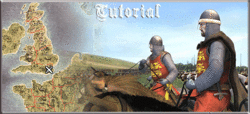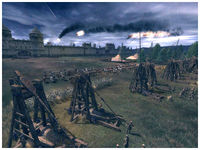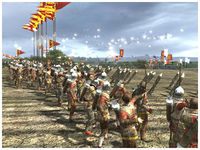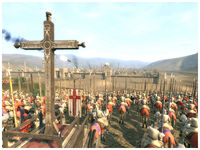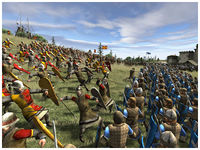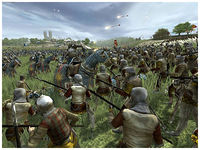Medieval II: Total War
| Total War Series |
|---|
|
Total War: Three Kingdoms - Portal Total War Saga: Thrones of Britannia Medieval II: Total War - Portal |
Medieval II: Total War, the indirect sequel to 2002's Medieval: Total War and the fourth game of the Total War series by The Creative Assembly, is a game of turn-based strategic rounds and real-time tactically-oriented battles. The game is set between the years 1080 and 1530. Like the original Medieval: Total War, it focuses on medieval warfare, religion and politics in Europe, North Africa and the Middle East. However, unlike its predecessors, the game has a tech tree which spans to the gunpowder age at the end of the game. The timeframe stretches into the era of the historical discovery of the New World, and simulates the discovery and conquest of the Americas. Medieval II is built on the code base of Rome: Total War.
Contents
Gameplay
Similar to previous titles of the Total War series, the game consists of two modes of play: battles and single-player campaign. Battles can be played in multiplayer, in user-defined scenarios, or in historical scenarios which simulate real battles such as the Battle of Arsuf or the Battle of Agincourt. Battles are also featured in the campaign.
Tutorial
The game starts with a tutorial based on the Battle of Hastings and the Norman Conquest. The player first takes the role of William Rufus, the son of the army commander William the Conqueror. His initial job is to provide a rearguard whilst the player learns the game controls. Then he joins to fight in the main battle. The player then concludes the tutorial with the conquest of Saxon England. At Hastings, King Harold is erroneously depicted with the Fleur-de-lis.
Campaign
The campaign allows the player to assume control of a faction of the time period, and build a civilization, both economically and militarily in order to conquer other factions. Gameplay consists of controlling the faction's military, economic, and social systems in large campaign maps. During the player's turn, armies, fleets, and agents can be moved on the map. When an army engages another army, the player can choose to fight the battle personally in the battle mode, or automatically calculate the outcome.
The goal of the campaign depends on which type of campaign is played. The short campaign requires the player to defeat one or two enemy factions (for example, the Holy Roman Empire must defeat its historical enemies Milan and Denmark) and control at least 15 settlements. The long campaign requires the player to control at least 45 territories and one or two significant cities, which are faction specific, such as Jerusalem, Granada, Rome or Constantinople.
Once the game is completed on any difficulty, the player may begin a new Grand Campaign as any faction with the exception of the Papal States, Mongols, Timurids, Aztecs (only encountered in the New World in the late period) or Rebels.
Settlements
Each faction controls a number of settlements, and must conquer others in order to continue growing. Unlike previous Total War titles, there are two kinds of settlements, each with different advantages and disadvantages: cities and castles. Castles have better defensive capabilities and have access to a larger selection of professional soldiers, but generate less income, cannot train as many priests as cities, and have no access to higher civilian technologies. Cities generate much larger income and are technological centers of a faction, but are more difficult to defend and only have access to militia troops, which are generally inferior to those trained at castles except for a select few unique units. A small quantity of militia troops, stationed in the city where they have been trained, can be kept for free, without upkeep cost, otherwise required to be paid every turn for every army unit. Players may convert a settlement to a different type, although larger cities may not be converted into castles. Castles also need less population to be upgraded.
As in other Total War games, in each settlement the faction may construct a number of buildings, each with different functions, such as training troops, upgrading weapons and armour, expanding the economy, increasing the settlement's defenses or strengthening religion. A new feature of Medieval II is the ability to build guild halls. A given settlement may only have a single guild hall, although there are several different types. The guild hall provides certain bonuses such as increased movement for troops, better weapons, or better agents; some even grant access to new units, such as the ahistoric yet effective unit of "Sherwood Archers" available to England upon construction and subsequent upgrade of a Woodsmens' Guild. Guild halls may also be later upgraded to a "Master Guild Hall", which may provide a larger bonus or even grant a bonus to all of the faction's settlements while still retaining a more notable bonus in the city the structure is built, and then possibly upgraded to the "Guild Headquarters", which provides the greatest bonuses, although each guild can have only one headquarters anywhere in the world at the given time, and each faction can only construct one Master Guild Hall of each guild in their empire. It is possible however, to capture a city with an existing Master Guild Hall of a certain type, and have two of one kind.
Characters
Each faction has a ruling family. Once male family members come of age at 16, they act as units that can be used to govern settlements and lead armies in battle as generals. Each character has attributes that determine their prowess in both. A character's actions can affect his attributes - for example, a general who routinely kills prisoners of war and exterminates captured settlements may see his "dread" increase, making him frightening to foes; a general who prefers to release prisoners and occupy settlements may instead increase his "chivalry", which makes his own troops much more brave. Characters also develop (or regress) by gathering traits and retinue members. Characters can take after (or rebel against) their parents, traits like alcoholism are self-perpetuating, inbreeding tends to strengthen when inherited, naivete and paranoia are mutually exclusive but both detrimental, etc. Some traits, mostly positive, are brought out by victories in battle: for example, generals can become increasingly scarred as time goes on, giving them more hitpoints, and generals who successfully complete a Crusade gain chivalry, command, and piety points. Others accumulate while governing a city: poorly managed backwaters tend to bring out the worst in generals, whereas advanced, central cities improve a general's traits. Owners of strong traits earn epithets, such as "the Brave," "the Just," "the Lewd" or "the Corrupt." These are decorative. A very important aspect of generals is their loyalty. If a general is disloyal, he may rebel, turning into the 'Rebels' faction and taking a part of the army at his command with him.
Captains are leaders of armies that do not have a family member controlling them. They don't have any special attributes or retinue, but if killed in battle troop morale decreases, increasing the chance that the army will rout. If killed or assassinated, a new captain will instantly appear and take command of the army in question. If a captain is victorious in a particularly one sided battle or has shown excellent leadership, he may catch your attention as the 'Man of the Hour', giving the option to adopt him into the Royal Family. If adopted, he turns into a general and may gain attributes and retinue. If declined, he continues to be a generic captain. An army left with only a captain to leave it may rebel and join the rebel factions.
Each faction has a number of agents it may use to maintain order and influence other factions. These include the Priests/Imams, as well as princesses, diplomats, merchants, assassins and spies. Each agent has attributes that develop the more he is able to successfully be used. Princesses, for example, have a "Charm" attribute that governs their success in diplomacy and the likelihood that a proposal in marriage will be accepted. Spies and Assassins have a "Subterfuge" attribute which governs how likely they are to infiltrate enemy cities or find information about enemy armies. All agents except princesses are trained at settlements which contain the appropriate buildings - for example, Christian priests can be trained in any settlement with a church or chapel. Princesses are born into the player's ruling family, and become active as agents once they come of age at 16.
Diplomacy is performed by diplomats and princesses and functions much as in previous Total War games, mainly involving negotiating treaties such as ceasefires, alliances and marriages and wars. The interface for negotiation has changed from previous games; a new system has been integrated to show the other faction's attitude toward the player's faction, intelligence estimates (such as how wealthy the faction is and what other factions they are at war with), as well as how fair the other faction feels the player's proposals are.
Inquisitors are controlled by the Papal States and are sent to the player's lands if you have fallen out of favour with the Pope. They can accuse any agent of heresy, and if they are found guilty, they will be executed. Generals, and even a player's King, may fall prey to these agents of God. To get rid of Inquisitors, you can gain favour with the Pope by building churches and converting the population, and avoid attacks on any more favourable Christian nations, or perhaps even attempt to assassinate the Inquisitors themselves.
Turn system
Medieval uses a system of "turns". Each turn represents 2 years; the year and the season will change accordingly each turn. A side effect of this system is that there are inconsistencies. For example, due to the movement system, when discovering America, it takes about 8-10 turns (i.e., 16-20 years because each turn represents 2 years) to get to America from western Europe; Christopher Columbus took about a month to make each of Voyages of his first two voyages. Another issue with the turn system is that, while it's designed to advance only 6 months per turn (Character aging), the actual time is 2 years. This means winter and autumn transitions happen unrealistically, and that monarchs will reign for hundreds of years.
Factions
- -See main article:Medieval II: Total War Factions
There are twenty-one factions, of which seventeen are playable in the Campaign game, although only five are playable in the beginning: The Kingdoms of England, France and Spain; the Holy Roman Empire as well as the Republic of Venice. The other factions may be unlocked one at a time, as soon as the player has defeated that faction in the campaign by conquering all their settlements including occupied temporary forts or by killing off the entire royal family of that faction, regardless of whether the player wins the entire campaign or not. The unlockable factions may be unlocked all at once by successfully winning the short or long campaign as one of the five initially available factions, and include Portugal , Scotland, the Moors, Egypt, the Turks, the Byzantine Empire, the Kingdom of Sicily, Milan, Denmark, Russia, Poland, and Hungary. The only factions that cannot be played are the Papal States, the Mongols, the Aztecs, the Timurids and the Rebels.
Each faction has at least one unit that is available to only that faction. One of these units from each faction is listed on the game as the faction's "special unit".
The factions in the game represent, to varying accuracies, their real-life historical factions. The army unit types available to each faction are modelled to reflect their real-life histories, with each faction possessing unique characteristics that afford them certain strengths against other factions in combat, as well as weaknesses. There are various simplifications in the game to make factions more identifiable. For example, the faction Russia did not exist as a state at the time but were divided into Fiefdoms, Principalities and states; with Kievan Rus' and then the Republic of Novgorod chronologically being the most prominent states. Spain also didn't exist at this time, and was divided into the kingdoms of Kingdom of Castille and Kingdom of Aragon, with Spain representing the former in the game. Also, Portugal didn't become an actual kingdom until 1139 and King Afonso I of Portugal is born 30 years before he was historically known, as well as erroneously possessing the territory of Navarre, which was historically independent.
Units
- -See main article:Medieval II: Total War Units
Battle system
One of the main focuses on the Total War franchise is its incorporation of battle within the greater sphere of gameplay. A battle consists of two or more factions' armies fighting each other. Battles play similar to those in Rome: Total War, with formations of various kinds of troops fighting. The objective of the battle is to defeat the enemy army by completely destroying it or causing the whole army to flee; in a siege battle, the objective is to completely destroy the army or to take control of a plaza in the center of the settlement. There is also an option which allows the player to allow for time limits on battles, meaning that the attacker must defeat the defender within a certain time limit (determined by the computer) or the battle results in a victory for the defender.
Unlike in previous Total War titles, a new system of modeling troops on the battlefield has been introduced. Each soldier has a varying number of elements to him, such as arms, legs, body armor, shield heraldry, and so forth; each element has a varying number of styles. When a battle is entered, the computer randomly selects elements for each soldier in the unit, thereby making each soldier look different from the soldiers around him. This can lead to some errors though, for example a general's bodyguard of the Holy Roman Empire can be portrayed with a shield with an English or Byzantine twist upon it. Upgrades to a unit's armor are also depicted - a unit of unarmored spearmen upgraded to have leather armor will be depicted wearing it. Another departure from earlier Total War games is that combat is depicted more realistically, with soldiers performing motion-captured attacks - rather than one or two standard attacks - utilizing their shields, parrying blows and delivering killing strikes to downed foes, all based on the weapon they are using and the weapon of their opponent. Blood can also be seen on the uniforms of soldiers who have been fighting and a mist of blood will be visible on soldiers hit by arrows. The amount of detail in the fight sequences can be turned up or down along with the other video options in the main menu. A player can also have up to 4800 (huge units option) troops in their army.
Like in Rome: Total War, mercenaries can also be hired. Special mercenaries are available during Crusades & Jihad, such as Crusader knights and fighting monks and Mutatawwi'a's for Jihad Armies.
Patches
The Creative Assembly developers stated on December 1, 2006 that they were working on a patch to solve reported bugs, specifically mentioning a major bug in how the game handles cavalry charges (the cavalry doesn't always use its lances when charging); the patch was released on December 15, 2006. A second patch was also released on May 4, 2007 solving many other problems not addressed in the first patch, though many of the pathfinding bugs in siege battles still remain.
An unofficial version of patch 1.2 was circulating in the community for a while. This patch 'escaped' due to the CA sending the download to various mirror sites before the official release time. They subsequently discovered some bugs, which were not resolved at that stage and decided to cancel the release of the patch, but the few of the sites that had been sent the preliminary patch released it anyway. This patch is superseded by the "final" 1.2 patch.
Many people have also commented on the size of the download for the second patch, being approximately 613MB in size (compared with the English-language version of patch 1.1 at 39.46MB)
Patch 1.3 for the game was released at the same time as the Kingdoms expansion and addresses some compatibility issues and is automatically installed with the expansion. It is another large patch, at 546MB. This patch includes online multiplayer fixes to allow owners of the original game to play with those who have installed Kingdoms. However, aside from making multiplayer games compatible between main game and expansion, this patch addressed none of the bugs still in the game (with the exception of the AI boat transport bug, which was fixed). The 1.3 patch requires patch 1.2 to have been installed. The last patch came out very late after the release of it's expansion pack and was for kingdoms that is Patch v1.5.
Info on Patches on where to download them can be found here on TWC.
Expansion
- -See main article: Medieval II: Total War Kingdoms
On March 30, 2007, an expansion, Medieval II: Total War: Kingdoms, was announced. It was later released on August 28, 2007 in the US, August 31 in the UK, and September 7 in Australia. It adds four new campaigns to the game:
- Americas Campaign - 7 playable factions (New Spain, The Aztecs, Mayans, Apachean Tribes, Chichimeca, Tlaxcalans and Tarascans) on a map of the New World from Guyana to Texas.
- Britannia Campaign - 5 playable factions (England, Ireland, Scotland, Wales, Norway) on a map of the British Isles.
- Crusades Campaign - 5 playable factions (Kingdom of Jerusalem, Principality of Antioch, Egypt, Turks, Byzantium) on a map of Egypt, the Levant and Anatolia.
- Teutonic Campaign - 4 playable factions (Teutonic Order, Lithuania, Denmark, Novgorod), and 2 unlockable (Poland and the Holy Roman Empire) on a map of northeastern Europe from eastern Germany to Russia.
On each of the expansions, a small part of the world map is taken (e.g Britain) and many settlements are added to it. Whereas Britain in the main game has a total of 7 settlements, the Britannia Campaign contains many more.
Screenshots
System Requirements
The Minimum System Requirements are as follows:
- English version of Microsoft® Windows® 2000/XP
- Celeron 1.5GHz Pentium 4® (1500MHz) or equivalent AMD® Athlon 64
- 512MB RAM
- DVD-ROM Drive capable of reading dual-layer DVDs
- 9GB of uncompressed free hard disk space
- 100% DirectX® 9.0c compatible 16-bit sound card and latest drivers
- 100% Windows® 2000/XP compatible mouse, keyboard and latest drivers
- DirectX® 9.0c
- 128MB Hardware Accelerated video card with Shader 1 support and the latest drivers. Must be 100% DirectX® 9.0c compatible*. The Nvidia® GeForce 4 Ti 4400 or the ATI radeon® 9600 SE is the recommended minimum video card.
- Monitor must be able to display 1024x768 resolution or above
The Recommended System Requirements are as follows:
- English version of Microsoft® Windows® XP
- Pentium 4® 2.4GHz (2400MHz) or equivalent AMD® Athlon 64
- 1GB RAM
- DVD-ROM Drive capable of reading dual-layer DVDs
- 9GB of uncompressed free hard disk space
- Sound Blaster Audigy or equivalent
- 100% Windows® 2000/XP compatible mouse, keyboard and latest drivers
- DirectX® 9.0c
- 128MB Hardware Accelerated video card with Shader 2 support and the latest drivers. Must be 100% DirectX® 9.0c compatible*. The Nvidia® GeForce 7300 or greater, or the ATI Radeon® X1600 or greater is recommended.
- Monitor capable of displaying 1280x1024 resolution or above
For the Launcher:
- Internet Explorer 6 or Higher
- A Connection to the Internet
- Microsoft® .NET Framework 1.1 (Higher recommended)(installed with Medieval II)
- Microsoft® J# Redistributable(installed with Medieval II)
- Important Note: Please refer to your hardware
manufacturer for confirmation of 100% DirectX® 9.0c compatibility.
External links
- Medieval 2 on TWC
- Medieval 2 on Gamespot.com
- Medieval 2 on IGN.com
- Medieval 2 on Steampowered.com
- Medieval 2 on Heavengames.com
- Medieval II: Total War - A retrospective on ten years of success! from the Eagle Standard


